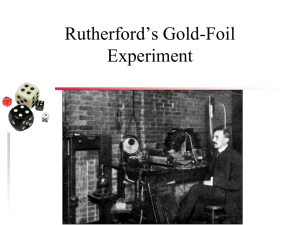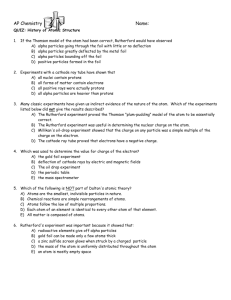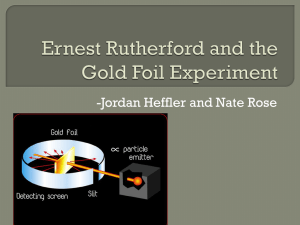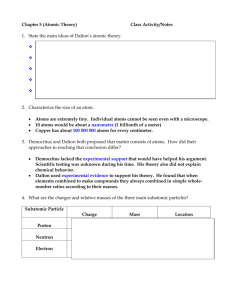Atomic Models student sheet
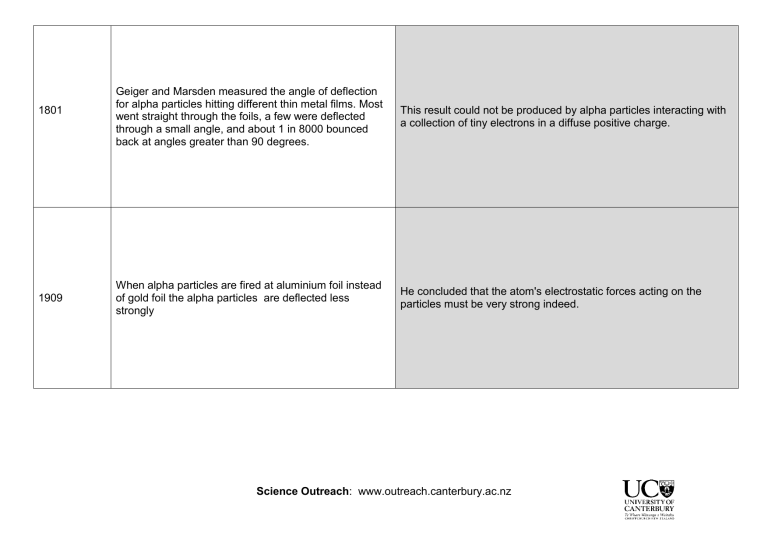
1801
Geiger and Marsden measured the angle of deflection for alpha particles hitting different thin metal films. Most went straight through the foils, a few were deflected through a small angle, and about 1 in 8000 bounced back at angles greater than 90 degrees.
This result could not be produced by alpha particles interacting with a collection of tiny electrons in a diffuse positive charge.
1909
When alpha particles are fired at aluminium foil instead of gold foil the alpha particles are deflected less strongly
He concluded that the atom's electrostatic forces acting on the particles must be very strong indeed.
Science Outreach : www.outreach.canterbury.ac.nz
1909
John Dalton published "Experimental Essays" on the constitution of mixed gases; on the pressure of steam and other vapours at different temperatures, both in a vacuum and in air; on evaporation; and on the thermal expansion of gases. He discovered that the total pressure exerted by a gaseous mixture is equal to the sum of the partial pressures of each individual component in a gas mixture. With careful measurement he also found that the volumes of gases reacting together were always in simple proportions such as 1:2 or 1:3. He weighed equal volumes of different gases and measured their weights, producing a table of values.
Alpha particles are doubly-ionised helium nuclei.
1907
Marsden, working at Rutherford's suggestion, investigated alpha particle beams hitting a gold foil and found that about 2% were reflected straight back
The atom is not indivisible but is made up of small, very light, negatively-charged particles, moving around in an atom with enough positive charge to make the whole atom neutral.
Science Outreach: www.outreach.canterbury.ac.nz
1897
If alpha particles hitting a metal foil are slowed down using mica film before the collisions, more particles are deflected at larger angles than when the particles are travelling fast.
Atoms consist of a very small, massive nucleus surrounded at much larger distances by electrons.
1905/6
Ernest Rutherford and Thomas Royds allowed alpha particles to penetrate a very thin glass wall of an evacuated tube, thus capturing a large number of the particles inside the tube. They then caused an electric spark inside the tube, which provided a shower of electrons that were taken up by the particles to form neutral atoms of a gas. Subsequent study of the spectra of the resulting gas showed that it was helium.
1.Elements are made of extremely small particles called atoms.
2.Atoms of a given element are identical in size, mass, and other properties; atoms of different elements differ in size, mass, and other properties.
3.Atoms cannot be subdivided, created, or destroyed.
4. Atoms of different elements combine in simple wholenumber ratios to form chemical compounds.
5. In chemical reactions, atoms are combined, separated, or rearranged.
Science Outreach: www.outreach.canterbury.ac.nz
1911
Rutherford noticed that a narrow beam of alpha particles, known to be positively-charged and travelling at around 10 000km/s, widened by 2 degrees as it travelled through air or a thin sheet of mica, but not if it travelled though a vacuum.
Confirms a nuclear atom as the nucleus of the smaller atom carries a smaller charge and so causes less deflection.
1911
JJ Thomson, studying the mysterious negativelycharged rays which streamed off a cathode in a vacuum tube, measured their electronic charge and found it to be the same as the charge carried by a hydrogen ion in electrolysis. He also measured its mass relative to a hydrogen atom and found it to be about 1000 times smaller. Thomson also found that these particles were identical, no matter what material they came from.
Confirms a nuclear atom as the slower particles are deflected more easily away from the nucleus.
Science Outreach: www.outreach.canterbury.ac.nz


